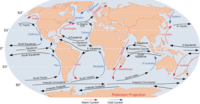
Photo from wikipedia
Recently published results of field and laboratory experiments on the seismic/acoustic response to injection of direct current (DC) pulses into the Earth crust or stressed rock samples raised a question… Click to show full abstract
Recently published results of field and laboratory experiments on the seismic/acoustic response to injection of direct current (DC) pulses into the Earth crust or stressed rock samples raised a question on a possibility of electrical earthquake triggering. A physical mechanism of the considered phenomenon is not clear yet in view of the very low current density (10−7–10−8 A/m2) generated by the pulsed power systems at the epicenter depth (5–10 km) of local earthquakes occurred just after the current injection. The paper describes results of laboratory “earthquake” triggering by DC pulses under conditions of a spring-block model simulated the seismogenic fault. It is experimentally shown that the electric triggering of the laboratory “earthquake” (sharp slip of a movable block of the spring-block system) is possible only within a range of subcritical state of the system, when the shear stress between the movable and fixed blocks obtains 0.98–0.99 of its critical value. The threshold of electric triggering action is about 20 A/m2 that is 7–8 orders of magnitude higher than estimated electric current density for Bishkek test site (Northern Tien Shan, Kirghizia) where the seismic response to the man-made electric action was observed. In this connection, the electric triggering phenomena may be explained by contraction of electric current in the narrow conductive areas of the faults and the corresponding increase in current density or by involving the secondary triggering mechanisms like electromagnetic stimulation of conductive fluid migration into the fault area resulted in decrease in the fault strength properties.
Journal Title: Earthquake Science
Year Published: 2017
Link to full text (if available)
Share on Social Media: Sign Up to like & get
recommendations!